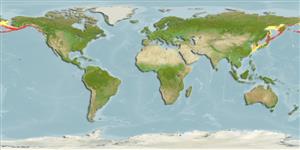Common names from other countries
Environment: milieu / climate zone / depth range / distribution range
বাস্তুসংস্থান
সামুদ্রিক তলদেশ বিহারী; গভীরতার পরিসীমা 0 - 335 m (Ref. 50550), usually ? - 70 m (Ref. 51666). Temperate; 66°N -
Northwest Pacific: western Bering Sea, Sea of Okhotsk, coasts of Japan to central Honshu, Sea of Japan to Korean Peninsula.
আকৃতি / ওজন / Age
Maturity: Lm ? range ? - ? cm
Max length : 20.0 cm SL পুরুষ/ লিঙ্গ অনিধর্ারিত ; (Ref. 559)
Found near shore among algae and rocks; usually shallower than 70 meters, but recorded to more than 300 meters (Ref. 51666).
Life cycle and mating behavior
পরিপক্কতা | প্রজনন | ডিম ছাড়া | ডিমসমূহ | ডিম্বধারন ক্ষমতা | শুককীট
Masuda, H., K. Amaoka, C. Araga, T. Uyeno and T. Yoshino, 1984. The fishes of the Japanese Archipelago. Vol. 1. Tokai University Press, Tokyo, Japan. 437 p. (text). (Ref. 559)
IUCN Red List Status (Ref. 130435)
CITES (Ref. 128078)
Not Evaluated
Threat to humans
Harmless
Human uses
আরো তথ্য
Age/Sizeবৃদ্ধিLength-weightLength-lengthLength-frequenciesমরফোমেট্রিক্সবহিঃ অঙ্গ সংস্থানশুককীট শুককীটের সত্রিুয়তা নির্বাচন প্রাচুর্য
সূত্র সংখ্যা এ্যাকুয়াকালচার (জলজ পালন) এ্যাকুয়াকালচার নকশা বংশ বংশানুগতিবিদ্যাElectrophoresesউতরাধিকার সুত্রে পাওয়া যোগ্যতারোগ প্রক্রিয়াজাতকরণ Mass conversion
সহযোগী ছবি সমূহStamps, Coins Misc.শব্দ ক্রোমোজোমের ধরণ গতি সাতাঁরের কায়দা ফুলকা এলাকাOtolithsমস্তিস্ক সমূহদৃষ্টি
হাতিয়ার
Special reports
Download XML
ইন্টারনেট সুত্র
Estimates based on models
Preferred temperature (Ref.
115969): 1.4 - 14, mean 5.1 (based on 142 cells).
Phylogenetic diversity index (Ref.
82804): PD
50 = 0.6250 [Uniqueness, from 0.5 = low to 2.0 = high].
Bayesian length-weight: a=0.00389 (0.00180 - 0.00842), b=3.12 (2.94 - 3.30), in cm Total Length, based on all LWR estimates for this body shape (Ref.
93245).
ট্রফিক পর্যায়ে (Ref.
69278): 3.3 ±0.5 se; based on size and trophs of closest relatives
Fishing Vulnerability (Ref.
59153): Low vulnerability (14 of 100).
